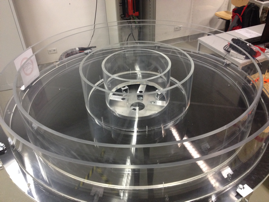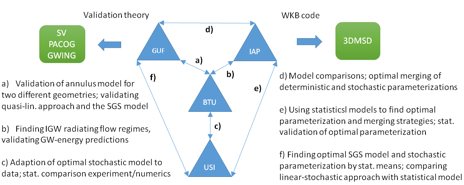Fluid Mechanics
DFG FOR 1898 „MS-GWaves“ "Multi-Scale Dynamics of Gravity Waves" (HA2932/8-1; FOR 1898)
The purpose of the DFG research unit MS-GWaves is to shed more light on a number of processes associated with internal gravity waves in the atmosphere. It is well known that gravity waves are not only relevant for their typical temporal and spatial scales of minutes to hours and 1 to 100 km. Gravity waves influence also the large scale dynamics in the troposphere and even drive the large scale circulation of the stratosphere and the middle atmosphere. In that sense, the internal gravity wave dynamics is a typical multi-scale problem and it is hence very difficult for numerical weather prediction models to resolve all relevant scales at the same time. Therefore, in the common weather prediction models, the effects of the small scale features on the large scale circulation are parameterized and hence not explicitly resolved. However, it is a difficult task to find the right parameterizations for different processes like orography, convection, or imbalance generated gravity waves.
It is the goal of MS-GWaves to introduce new parameterization schemes by better understanding several gravity wave processes. These are i) Gravity-Wave Interactions in a Global Context, ii) Processes and Climatology of Gravity waves, iii) Spatio-Temporal Gravity-Wave-Source Variability, iv) Modification of gravity waves propagating across the tropopause, v) Spontaneous Imbalance, and vi) 3D Multi-Scale Dynamics of Gravity Wave Propagation.
Spontaneous Imbalance
The project within the Department of Aerodynamics and Fluid Mechanics at BTU Cottbus-Senftenberg is focusing on v), Spontaneous Imbalance.
Gravity waves in the atmosphere can be emitted from different sources. A well investigated source is topography: winds, sweeping over mountains generate gravity waves that propagate upward into the stratosphere where they can break and deposit momentum, far away from their source region. Less well investigated are convectively generated gravity waves: thermal plumes rising upward can deform the tropopause. The deformation can generate gravity waves in the stably stratified stratosphere propagating further upward. A still puzzling wave generation process is spontaneous imbalance: large scale waves and fronts emit gravity waves even when such large scale flows are in quasigeostrophic equilibrium. The common understanding that suggests that large and small scale processes can be treated separately seems to be wrong and gravity waves can be seen an unavoidable requisite of the large scale flow. Presently, for this kind of gravity wave generation mechanism no parameterization exists mainly since this process is not sufficiently understood.
The spontaneous imbalance laboratory experiment
Large scale waves and fronts can be generated in a rather simple laboratory experiment. The differentially heated rotating annulus is a widely studied tabletop-size laboratory model of the general mid-latitude atmospheric circulation. The two most relevant factors of cyclogenesis, the generation of large scale waves and fronts, namely rotation and meridional temperature gradient are quite well captured in this simple arrangement. The radial temperature difference in the cylindrical tank and its rotation rate can be set so that the isothermal surfaces in the bulk tilt, leading to the formation of baroclinic waves and fronts.

These large scale baroclinic waves have experimentally been studied extensively over the last decades. However, whether these laboratory waves emit gravity waves is unknown and needs to be investigated. If gravity waves can be found for our setup, the experiment would form the ideal testbed for studying this important gravity wave source. The data will then be used by numerical modelers to verify their codes and to develop suitable parameterization schemes that in turn could be tested against the experimental data.
The partners of the spontaneous imbalance projects
The experiment is part of the Spontaneous-Imbalance-Group within the MS-GWaves project. This group consists of researchers from the Goethe Universität Frankfurt, Frankfurt/Main, the Leibniz-Institut für Atmosphärenphysik, Kühlungsborn, the Universita della Svizzera Italiana, Lugano, Switzerland and, finally, BTU Cottbus-Senftenberg. Numerical simulations will be done in Frankfurt and Kühlungsborn, statistical analyses will be done in Lugano, and we will add experimental data to the group. Below you find the interaction diagram showing the interaction of the subprojects within "spontaneous imbalance" and the other projects within the research unit

